Categories: Featured Articles » Novice electricians
Number of views: 114250
Comments on the article: 10
Battery Connection Diagrams
A combined group of batteries is called a cell battery or simply a galvanic battery. There are two main ways to connect cells to batteries: series and parallel.
In the framework of this article, we consider the features of series and parallel connection of batteries. There are different situations when it may be necessary to increase the total capacity or increase the voltage by resorting to parallel or serial connection of several batteries to the battery, and you always need to remember the nuances.
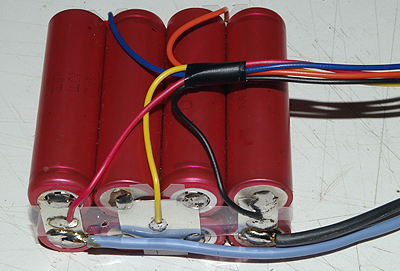
A parallel connection involves combining the positive terminals of the batteries with a common plus point of the circuit, and all negative terminals with a common minus, i.e., connect all the positive terminals of the elements to one common wire, and all the negative terminals to another common wire. The ends of the common wires of such a battery are connected to an external circuit - to the receiver.
The essence of a sequential method of connecting batteries, as its name implies, is that all the elements taken are connected together in a single sequential chain, i.e., the positive pole of each element is connected to the negative pole of each subsequent element.
As a result of such a connection, one common battery is obtained in which the negative end remains free for one extreme element and the positive conclusions for the second one. With the help of their battery and is included in the external circuit - in the receiver. Next, let's talk about this in more detail.
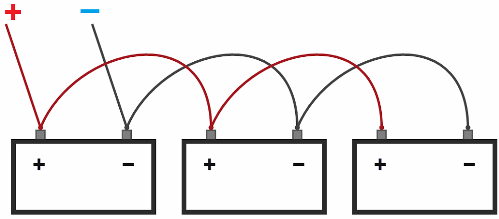
A parallel connection of the batteries gives a combination of capacities, and with equal initial voltage on each of the batteries included in the battery assembled from them, the capacity of the composite battery is equal to the sum of the capacities of these batteries. With equal capacities of the combined batteries, to find the battery capacity, it is enough to multiply the number of batteries making up the battery by the capacity of one battery in the assembly.
Parallel connection:
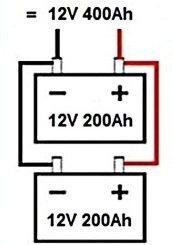
No matter how many elements we connect in parallel, their total voltage will always be equal to the voltage of one element, but then the discharge current strength can be increased as many times as many elements will be included in the battery, if all the elements in the battery are of the same type.
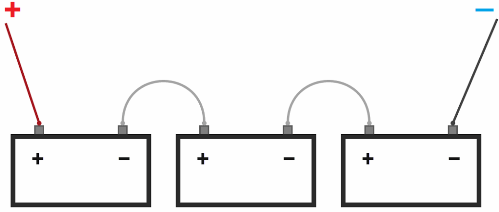
Connecting the batteries in series, get a battery of the same capacity as the capacity of one of the batteries included in the battery, provided that the capacities are equal. In this case, the voltage of the battery will be equal to the sum of the voltages of each of the batteries making up the battery.
If batteries of equal capacity and voltage equal at the time of connection are connected in series, then the voltage of the battery obtained by series connection will be equal to the product of the voltage of one battery and the number of batteries that make up the series circuit.
Serial connection:
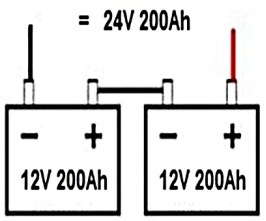
When the elements are connected in series, the values of their internal resistances also add up. Therefore, regardless of the magnitude of its voltage, a composed battery can consume only the same current strength as one element that is part of this battery is designed. This is understandable, since with a series connection, the current passes through each element, which passes through the entire battery.
Thus, by connecting the elements in series, increasing their total number, it is possible to increase the battery voltage to any limits, but the discharge current strength of the battery will remain the same as that of one separate element included in its composition.
Both in parallel and in series connection, the total energy of the battery is equal to the sum of the energies of all the batteries that make up the battery.
So, why are batteries combined into batteries? The thing is that in any circuit there are losses associated with the heating of conductors. And with the same resistance of the conductor, if you want to transfer a certain power, it is much more profitable to transmit power at a high voltage, then the current will need less, and the ohmic losses will be less.
For this reason, powerful uninterruptible power supplies use batteries of series-connected accumulators for a total voltage of several tens of volts, and not a parallel circuit of 12 volts. The higher the voltage of the source, the higher the efficiency of the converter.
When a significant current is needed, and one available battery is not enough for the intended purpose, the battery capacity is increased by resorting to the parallel connection of several batteries.
It is not always economically feasible to replace the battery with a new one that has a larger capacity, and sometimes it is enough to connect another one in parallel and increase the source capacity to the necessary. Some uninterruptible power supplies have compartments for installing additional batteries parallel to the existing one, in order to increase the energy resource of the converter.
What should be considered when combining batteries in a serial circuit? Batteries of different capacities (manufactured using the same technology, for example, lead-acid) are characterized by internal resistance. The higher the capacitance, the lower the internal resistance, the dependence here is almost inversely proportional.
For this reason, if you connect batteries of different capacities in series and close the load circuit or charging circuit, the current in the circuit will go the same everywhere, but the voltage drops will be different. And on some of the batteries of the battery, the voltage during charging will be much higher than the nominal value, which is dangerous, and when discharging, it will be much lower than the lower limit, which is harmful. Let's consider an example further, show what this is fraught with.
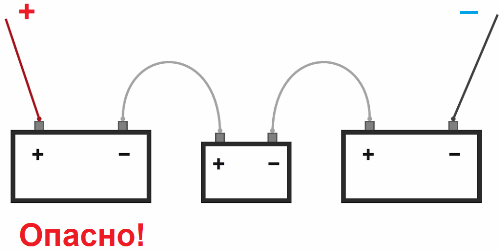
Let us have 10 batteries at our disposal, each with a rated voltage of 12 volts, 9 of them have a capacity of 20 ampere hours, and one 10 ampere hours. We decided to connect them in series, and charge from the charger with control of the charging current, set the current to 2 amperes. Charger configured so that it stops charging when the battery voltage crosses the 138 volt mark, based on an average of 13.8 volts for each battery in the serial battery. What will happen?
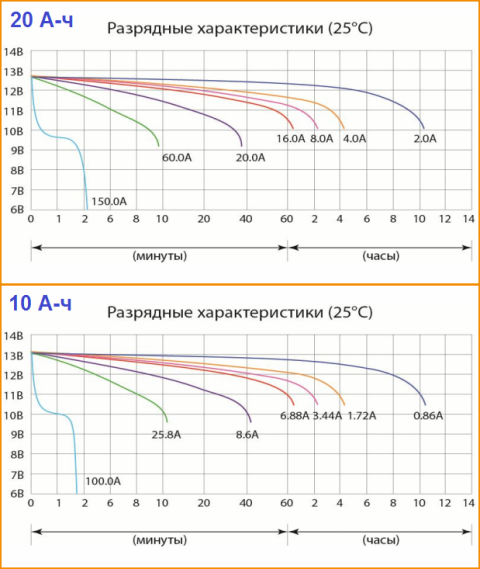
For each battery, the manufacturer provides a charging characteristic, where you can see how much current and for how long you need to charge the battery.
Obviously, a battery with 2 times less capacity at a current of 2 amperes will receive the same amount of energy as batteries with a larger capacity, but the voltage increase on it will go about three times faster. So, after 3 hours, the small battery will take its toll, at the same time, large batteries will need to be charged for another 6 hours.
But the voltage on the small battery has already gone over the edge, it would have to be put into voltage stabilization mode, it doesn’t do this on our charger. In the end, the gas recombination system in the battery will not withstand half the capacity, the valves will be torn off, and the battery will begin to lose moisture, lose capacity, while large batteries will still be undercharged.
Conclusion: only batteries of equal capacity, of the same technology, of the same discharge state can be charged sequentially.
Now suppose we discharge the same series circuit. Initially, each battery has 13.8 volts, and the discharge current is 2 amperes. Deep discharge protection will open the circuit at 72 volts, i.e. at least 7.2 volts per battery is assumed. After 4 hours, the small battery will be completely discharged, and on large ones there will still be 12 volts, and protection against deep discharge will not keep the trick.A small battery will already irreversibly lose part of its capacity.
That is why only batteries of equal capacities can be connected in series if you do not want to spoil them. It is best to connect the batteries from the same batch in series, and check their capacities with a battery tester beforehand to make sure that the capacities of the batteries from which you are going to assemble a serial battery are almost equal.
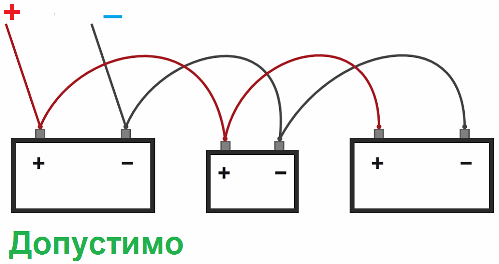
But in parallel to connect batteries of different capacities is acceptable. Of course, provided that the voltages at their terminals are equal. With a parallel connection, the battery capacities will not play a role, since the internal resistance of the batteries will be connected in parallel, and the maximum charge or discharge current will be different for each battery, they will work synchronously.
However, there are current limitations for the battery terminals and for each specific battery, the terminals may not withstand the continuous current that the battery can give in principle, it is important not to forget about this. In the technical documentation for the battery, these parameters are indicated.
If at the moment of connecting two batteries, which differ greatly in capacity, their voltages differ significantly, a short-term overcurrent of one of the batteries is inevitable. If the voltage is higher for a battery with a smaller capacity, then the redistribution of charge at the time of connection will cause a short-term short-circuit current in it, and can quickly lead to its destruction.
If the voltage is higher for a battery with a larger capacity, then again, a battery of a smaller capacity is at risk, because it will take charge in overload mode. Therefore, it is best to connect the batteries in parallel, having previously aligned the voltage on them, and by the next step to combine them into a battery.
We hope that our article was useful to you, and now you know how it is possible and how not to connect the batteries and for what purpose it is usually done.
See also at i.electricianexp.com
:
